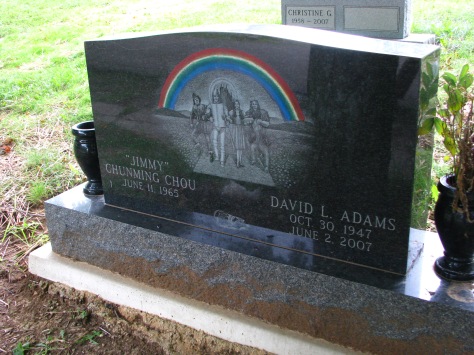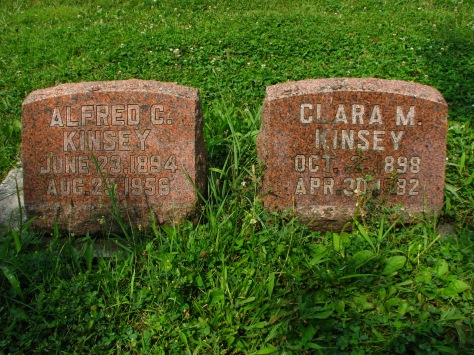I have always loved cemeteries, which to me are places of beauty and rest. Many people do not realize that impressive works of the stonecarver’s craft can be found during the course of a relaxing stroll.

Stone grave markers are an art form capable of generating a visual, even spiritual, impact, like the one below, which symbolizes the collapse of all our earthly constructs. (The back of this same marker shows the gates of heaven opening to admit the deceased.)
Bloomington’s three large cemeteries are Rose Hill, White Oak and Valhalla, but there are many other smaller ones that include Covenanter, Dunn (on the Indiana University campus) and Ketcham, to name just a few.

Different styles of stone markers were popular at different times throughout history. The earliest and simplest gravestones are simple slabs, but those who could afford it had many choices. The stone tree motif was very popular during the second half of the 1800s. Often adorned with stone ivy and stone ferns, the lopped-off branches of the tree are often commonly believed to represent the number of family members who had already died, but the broken branches probably indicate a simple general theme of decline and death.

Rose Hill cemetery contains a monument to the only Bloomington citizen lost on the Titanic: a wealthy young man who was returning from a trip to Europe. The tomb, of course, is empty.
People might be surprised to learn that in the earliest days of settlement, gravestones were almost unknown. There was no quarrying machinery on the frontier in settlement times (1780-1820) and stone had to be laboriously cut and shaped with hammer and chisel. Most graves in the early years were simply marked by a plank with the name of the deceased painted on it.

The marker above is NOT limestone but whetstone from Hindostan, Indiana, a hard, crisp stone which has beautifully maintained its cut and shape. Limestone became the usual default grave marker material simply because it’s so ubiquitous in Monroe County, but many old markers were also carved of white marble. These date to after 1853 (the first year the railroad reached Monroe County). Before that date it would have been extremely difficult to haul heavy blank marble gravestones by wagon all the way from the Ohio River to Bloomington.

Marble has the unfortunate tendency to erode under our increasingly acidic rains; limestone does not usually erode but tends to breed lichens and moss. Granite, however, is far harder, lichen-free and long-lasting. Currently, colored and etched surfaces are an eye-catching option for purchasers.

Bloomington’s Rose Hill cemetery has many distinguished residents, including Hoagy Carmichael, composer of many popular American hits such as “Heart and Soul,” “Georgia on My Mind,” “Stardust” and “Skylark.”
Hoagy’s marker is usually covered with coins, usually inserted into the incised lettering.
Another pair of famous residents are the renowned sex researchers, Alfred and Clara Kinsey.
The greatest production of the stonecarvers’ art is the monument to the Riddle brothers, who both died during World War I. Their family commissioned a stone soldier carved with painstaking detail and erected it in the cemetery just north of Lake Lemon.

Unfortunately, this priceless piece of carving has been vandalized, like so many other grave markers.

It’s hard to fathom what kind of person gets a thrill from smashing beautiful markers in quiet cemeteries, but there it is: a pure act of contempt for other people’s loved ones, and contempt for these masterly works in stone that have been left undefended.
The next time you’re near a cemetery, go in and wander around. You’ll enjoy a relaxing and serene stroll across smooth grass to the sound of birdcalls. Each one is a special place worthy of our admiration.






Carrol,
This post incites several wanderings of my mind.
1) I know of and often hike to a very secluded cemetery in Bridgewater VT. The graves must be limestone not granite. The community was settled c. 1812-ish according to the remaining markers. Unfortunately, over the years, many of the tombstones have been stolen and now there are only @ 2 left. Such an insult to some of the revolutionary war veterans resting there.
2) Yes, indeed, the headstone carvers are artists. There are several cemeteries in Barre Vermont that have Italian carvers. Barre VT is known for its granite quarries and many folks migrated there to work the stone.
There was a PBS specula recently about this…dont remember the details.
3) Check out the Mt. Auburn Cemetery in Cambridge Mass. Several dignitaries are buried there including Buckminster Fuller, Ralph Waldo Emerson etc. etc.
4) What is the name of the cemetery in Bloomington that I used to live across the street from??? Was it on third or 5th st???
Love this stuff…
LB
LikeLike
Thanks for writing, Laurie! New England has beautiful cemeteries with outstanding carvings and inscriptions, as I remember. Bloomington also had some highly skilled Italian stonecarvers…apparently many of them immigrated from the old country and dispersed across the United States. And the Bloomington cemetery you’re thinking of, where all the photos except the stone soldier were taken, is Rose Hill, on Bloomington’s west side. 🙂 all best, Carrol
LikeLike
My father, Warren Roberts, did research on carved limestone gravestones, and led some tours. His work was published and well-received. Have you read it?
LikeLike
No, I have not. Where can I find it… maybe the History Center? The Indiana Room? I would very much like to read it. 🙂
LikeLike
I am a former native Bloomingtonian and have photographed family tombstones, always wondering if others would find that odd. Apparently not. Thank you.
LikeLike
Nan, thanks for reading and commenting! Most cemeteries are indeed restful and beautiful places. The best cemeteries in the nation were intentionally designed to be visually appealing and well laid out. I grew up in Louisville, KY, and we often visited Cave Hill, a notable Victorian cemetery with beautiful grounds and outstanding monuments. That probably instilled me with a lifelong admiration for cemeteries! —Carrol
LikeLike